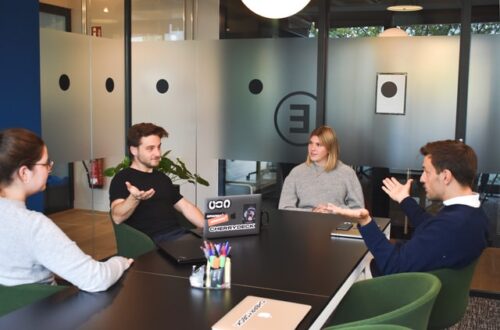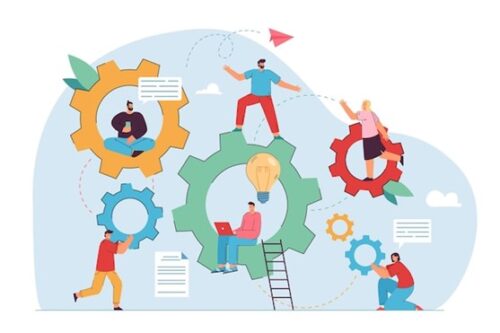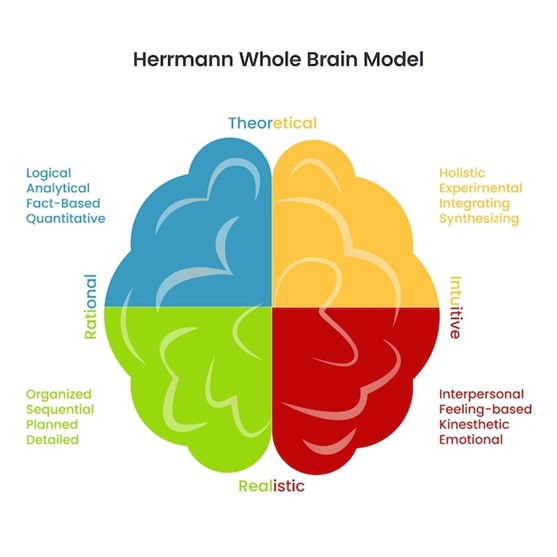The HBDI®, also known as the Herrmann Brain Dominance Instrument, is an exceptional tool specifically designed to evaluate and comprehend the thinking and information processing methods of individuals. Created by Ned Herrmann, this instrument offers valuable insights into an individual’s preferred thinking style, aiding in the identification of cognitive strengths and areas for improvement. By grasping the essence of the HBDI® profile, individuals can delve deeper into their own thinking patterns and utilize this knowledge to enhance their communication skills, problem-solving abilities, and decision-making prowess. This HBDI guide provides comprehensive information on understanding what HBDI® is, its significance in neurodiversity and cognitive diversity, as well as how to utilize it for whole brain development.
Are you wondering what HBDI is?
HBDI, which stands for Herrmann Brain Dominance Instrument, is a psychometric assessment that evaluates thinking preferences based on the concept of Whole Brain Thinking. This assessment categorizes thinking into four quadrants: A, B, C, and D. These quadrants represent analytical, practical, relational, and experimental thinking styles respectively. Each person has their own unique HBDI® profile that reflects their preference for one or more thinking styles. The HBDI profile is visually represented by a colorful graph and provides valuable insights into an individual’s thinking preferences. If you’re interested in exploring your own cognitive diversity or want to use HBDI for Whole Brain development purposes, this comprehensive guide will help you understand how to interpret your HBDI® profile and leverage neurodiversity to enhance your cognitive capabilities.
How does HBDI work?
The HBDI assessment, known as the HBDI® profile, provides a guide to understanding an individual’s thinking preferences across the four quadrants. To generate this profile, individuals are asked a series of questions and must choose their preferred responses from a set of options. These questions are carefully designed to measure cognitive diversity and reveal an individual’s thinking preferences.
The HBDI assessment considers both left and right brain thinking processes. The left brain is responsible for analytical and logical thinking, while the right brain is associated with intuitive and creative thought. By analyzing the responses, the HBDI assessment provides valuable insights into an individual’s neurodiversity.
For a comprehensive understanding of cognitive diversity, many individuals turn to HBDI for Whole Brain guidance. This process analyzes the responses to offer a complete picture of an individual’s thinking preferences, helping them optimize their performance in various areas.
Understanding the HBDI® profile
The HBDI® profile is a visual representation of an individual’s thinking preferences. It consists of a colorful graph that displays the individual’s preference for each thinking style quadrant. The colors on the graph indicate the strength of preference for each quadrant, with the most preferred quadrant being the one with the highest intensity of color.
The HBDI® profile provides valuable insights into an individual’s thinking preferences. It helps individuals understand how they approach problem-solving, decision-making, and communication. By understanding their thinking preferences, individuals can leverage their strengths and develop strategies to enhance their performance in areas where they may be less dominant.
Benefits of using HBDI for Whole Brain Thinking
The HBDI assessment and the concept of Whole Brain Thinking offer several benefits for individuals and organizations. By understanding their thinking preferences, individuals can:
- Improve communication: By understanding the thinking preferences of others, individuals can adapt their communication style to effectively connect with different thinking styles. This leads to more productive and collaborative interactions.
- Enhance problem-solving: The HBDI provides a framework for approaching problem-solving from multiple perspectives. By considering different thinking styles, individuals can generate more creative and innovative solutions to complex problems.
- Optimize decision-making: The HBDI helps individuals make more informed decisions by considering a broader range of perspectives. By leveraging the strengths of different thinking styles, individuals can make decisions that are more comprehensive and well-rounded.
- Foster innovation: Whole Brain Thinking encourages the integration of diverse perspectives and ideas, leading to increased innovation and creativity within teams and organizations.
Exploring Neurodiversity and Cognitive Diversity in the HBDI® Profile
One of the fundamental principles of the HBDI® assessment is its acknowledgment and celebration of neurodiversity and cognitive diversity. Neurodiversity encompasses the inherent variability in individuals’ thinking processes, information processing, and perception of the world. Meanwhile, cognitive diversity refers to the assortment of thinking styles and preferences found within a group or organization.
The HBDI® Guide recognizes that there is no universal approach to thinking and problem-solving that fits everyone. Instead, it encourages understanding and embracing different ways of thinking through its comprehensive Whole Brain approach.
By embracing neurodiversity and cognitive diversity, organizations can foster an inclusive and innovative culture that values and appreciates the contributions of all individuals.
How to interpret and apply your HBDI results
Interpreting and applying your HBDI results is a crucial step in leveraging the insights gained from the assessment. Here are some tips for making the most of your HBDI® profile:
- Understand your thinking preferences: Take the time to explore and understand your HBDI® profile. Identify your preferred thinking styles and consider how they influence your approach to problem-solving, decision-making, and communication.
- Leverage your strengths: Once you understand your thinking preferences, identify ways to leverage your strengths in different situations. For example, if you have a strong preference for analytical thinking, you can use this to your advantage when working on data-driven projects or complex problem-solving tasks.
- Develop your weaker areas: Identify areas where you may be less dominant and develop strategies to enhance your skills in those areas. For example, if you have a weaker preference for relational thinking, you can work on improving your communication and interpersonal skills to enhance collaboration with others.
- Adapt your communication style: Use your knowledge of different thinking styles to adapt your communication style to effectively connect with others. Consider how others might prefer to receive information and tailor your approach accordingly.
- Seek feedback and collaborate: Engage in open and honest conversations with others to gain a better understanding of their thinking preferences. Collaborate with individuals who have different thinking styles to leverage their unique perspectives and enhance your own problem-solving and decision-making processes.
HBDI Guide: Tips for maximizing your HBDI assessment
- Prepare for the assessment: Before taking the HBDI assessment, familiarize yourself with the concept of Whole Brain Thinking and the different thinking styles represented by the quadrants. This will help you approach the assessment with a better understanding of what it measures and what insights it can provide.
- Answer honestly: The HBDI assessment is most effective when individuals answer the questions honestly and reflect their true thinking preferences. Avoid overthinking or trying to give “correct” answers. Instead, trust your instincts and provide responses that accurately represent your thinking style.
- Reflect on your results: After receiving your HBDI® profile, take the time to reflect on the insights gained. Consider how your thinking preferences align with your current role and responsibilities. Identify areas where you can leverage your strengths and areas where you may need to develop further.
- Seek professional guidance: If you feel overwhelmed or unsure about how to interpret and apply your HBDI results, consider seeking professional guidance. WHS and Training Compliance Solutions offer HBDI® profile reviews and can provide valuable insights and recommendations based on your individual profile.
HBDI in the workplace: Enhancing team collaboration and communication
The HBDI assessment and Whole Brain Thinking have significant implications for team collaboration and communication in the workplace. By understanding the thinking preferences of team members, leaders can create an environment that values and leverages diverse perspectives. This can enhance team dynamics, foster creativity, and drive innovation.
When teams are composed of individuals with different thinking styles, they are more likely to approach problems from multiple angles, consider a broader range of solutions, and make more informed decisions. This diversity of thinking can lead to more robust problem-solving and higher-quality outcomes.
Additionally, the HBDI assessment can be used to improve communication within teams. By understanding the thinking preferences of team members, individuals can adapt their communication style to effectively connect with others. This leads to clearer communication, reduced misunderstandings, and stronger relationships within the team.
HBDI training programs
To maximize the benefits of the HBDI assessment, many organizations offer HBDI training programs. These programs provide individuals and teams with the knowledge and skills to effectively apply Whole Brain Thinking in their work. HBDI training programs typically cover topics such as understanding thinking preferences, leveraging strengths, enhancing communication, and fostering innovation.
HBDI training programs can be customized to the specific needs and goals of an organization. They can be delivered through workshops, seminars, or online platforms, allowing individuals to learn at their own pace. By investing in HBDI training programs, organizations can empower their employees with the tools and mindset needed to embrace cognitive diversity and drive organizational success.
Conclusion: Enhancing Cognitive Diversity with the HBDI ® Profile Guide
The HBDI® assessment is an invaluable resource for gaining insights into thinking preferences and fostering cognitive diversity at both the individual and organizational levels. By embracing the principles of Whole Brain Thinking, individuals can harness their distinct strengths and perspectives to elevate their problem-solving abilities, decision-making processes, and communication skills. This holistic approach highlights the importance of neurodiversity and positions HBDI as a comprehensive tool for cultivating cognitive diversity within diverse teams.
By utilizing the HBDI assessment, individuals can acquire invaluable insights into their thinking preferences and effectively devise strategies to enhance their performance. Moreover, organizations have the opportunity to cultivate an all-encompassing and forward-thinking environment by fully embracing both neurodiversity and cognitive diversity. This approach ultimately paves the way for success and fosters exponential growth. The HBDI Guide, HBDI® profile, and the concept of using HBDI for Whole Brain are instrumental in bringing about these transformative outcomes.
If you’re looking to uncover the mysteries surrounding your own HBDI profile, reach out to WHS and Training Compliance Solutions for a thorough HBDI profile review. With their specialized knowledge, they can help you gain a more profound insight into your thinking preferences and provide guidance on how to optimize your potential.
For a comprehensive understanding of your HBDI® profile and to explore the realms of neurodiversity and cognitive diversity, get in touch with WHS and Training Compliance Solutions. Their expertise in HBDI for Whole Brain will assist you in unraveling the secrets behind your unique thinking patterns. Maximize your potential with HBDI Guide today! Contact us.












